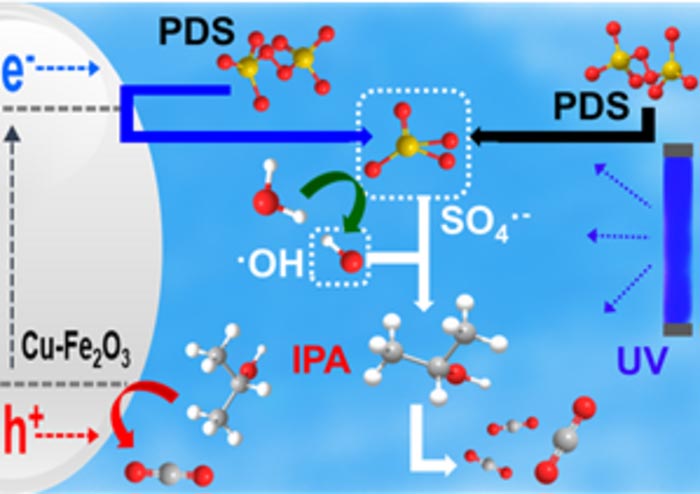New technology for wastewater treatment for semiconductor production

Mechanism of Isopropyl alcohol (IPA) decomposition during photo-Fenton oxidation using the developed catalyst
Credit: Korea Institute of Science and Technology (KIST)
Photocatalysis-based prompt and complete removal of trace amount of alcohol in water.
Alcohols are used to remove impurities on the surface of semiconductors or electronics during the manufacturing process, and wastewater containing alcohols is treated using reverse osmosis, ozone, and biological decomposition. Although such methods can lower the alcohol concentration in wastewater, they are ineffective at completely decomposing alcohols in wastewater with a low alcohol concentration. This is because alcohol is miscible in water, making it impossible to completely separate from alcohol using physical methods, while chemical or biological treatments are highly inefficient. For this reason, wastewater with a low alcohol concentration is primarily treated by diluting it with a large amount of clean water before its discharge.
The Korea Institute of Science and Technology (KIST, President Seok-Jin Yoon) has announced that a research team led by Dr. Sang Hoon Kim and Dr. Gun-hee Moon of Extreme Materials Research Center developed a photocatalyst that can completely decompose a trace amount of alcohol in water within a short duration by adding a very trace amount of copper to iron oxide, which is used as a catalyst during the advanced oxidation process.
The research team employed Fenton oxidation that uses oxidizing agents and catalysts during the advanced oxidation process for water treatment. Usually alcohols were used as reagents to verify radical production during Fenton oxidation in other advanced oxidation process (AOP) studies, they were the target for removal from semiconductor wastewater in this research.
This water treatment technology is expected to dramatically reduce the cost and water resources invested into the treatment of semiconductor wastewater. In the past, clean water with a volume 10 times higher than that of the wastewater under treatment was required for dilution of the wastewater in order to reduce the alcohol concentration of 10 ppm in the wastewater to less than 1 ppm.
If the photocatalyst developed by the KIST is used for water treatment, water resources can be saved. The research team applied the photocatalyst to wastewater from a semiconductor factory to prove that alcohol decomposition levels similar to those observed in the laboratory could be achieved in industrial practice.
“As large-scale semiconductor production lines are established, we expect that there will be a rapid increase in the demand for the treatment of semiconductor wastewater,” said Dr. Kim. “The results of our research will provide a solution to effectively treat semiconductor wastewater using less resources and at a lower cost,” he added.
KIST was established in 1966 as the first government-funded research institute in Korea to establish a national development strategy based on science and technology and disseminate various industrial technologies to promote the development of major industries. KIST is now elevating the status of Korean science and technology through the pursuit of world-leading innovative research and development. For more information, please visit KIST’s website at https://eng.kist.re.kr/
The research was funded by the Korea Materials Research Center of the Korean Ministry of Science and ICT (Minister Jong-Ho Lee), the Environmental Technology Development Project of the Korean Ministry of Environment and basic projects of the Korea Institute of Science and Technology. Related research papers are published in the Chemical Engineering Journal, a reputable academic journal in the chemical engineering and environmental fields.
Journal: Chemical Engineering Journal
DOI: 10.1016/j.cej.2022.139048
Article Title: Control of copper element in mesoporous iron oxide photocatalysts towards UV light-assisted superfast mineralization of isopropyl alcohol with peroxydisulfate
Article Publication Date: 5-Sep-2022
All latest news from the category: Materials Sciences
Materials management deals with the research, development, manufacturing and processing of raw and industrial materials. Key aspects here are biological and medical issues, which play an increasingly important role in this field.
innovations-report offers in-depth articles related to the development and application of materials and the structure and properties of new materials.
Newest articles

NASA: Mystery of life’s handedness deepens
The mystery of why life uses molecules with specific orientations has deepened with a NASA-funded discovery that RNA — a key molecule thought to have potentially held the instructions for…

What are the effects of historic lithium mining on water quality?
Study reveals low levels of common contaminants but high levels of other elements in waters associated with an abandoned lithium mine. Lithium ore and mining waste from a historic lithium…

Quantum-inspired design boosts efficiency of heat-to-electricity conversion
Rice engineers take unconventional route to improving thermophotovoltaic systems. Researchers at Rice University have found a new way to improve a key element of thermophotovoltaic (TPV) systems, which convert heat…



